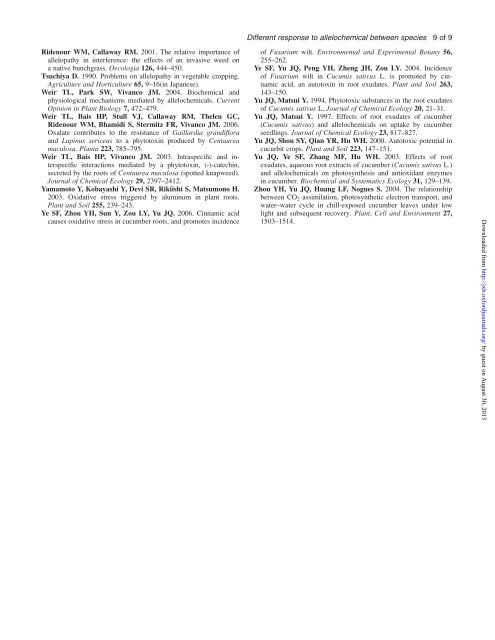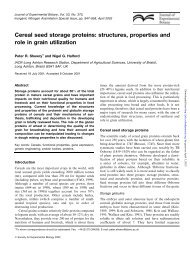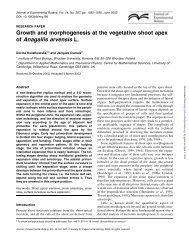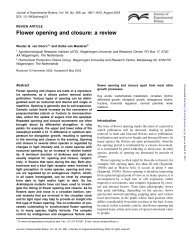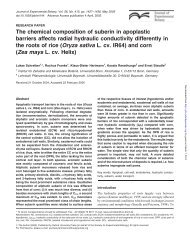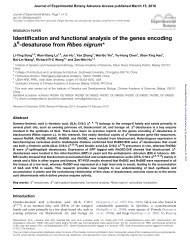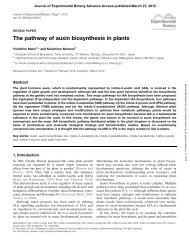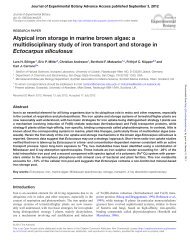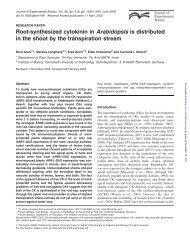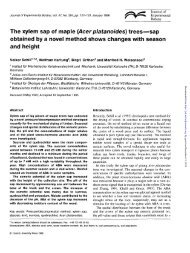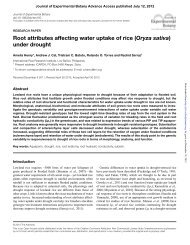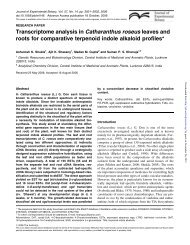Physiological basis of different allelopathic reactions of cucumber ...
Physiological basis of different allelopathic reactions of cucumber ...
Physiological basis of different allelopathic reactions of cucumber ...
Create successful ePaper yourself
Turn your PDF publications into a flip-book with our unique Google optimized e-Paper software.
Ridenour WM, Callaway RM. 2001. The relative importance <strong>of</strong><br />
allelopathy in interference: the effects <strong>of</strong> an invasive weed on<br />
a native bunchgrass. Oecologia 126, 444–450.<br />
Tsuchiya D. 1990. Problems on allelopathy in vegetable cropping.<br />
Agriculture and Horticulture 65, 9–16(in Japanese).<br />
Weir TL, Park SW, Vivanco JM. 2004. Biochemical and<br />
physiological mechanisms mediated by allelochemicals. Current<br />
Opinion in Plant Biology 7, 472–479.<br />
Weir TL, Bais HP, Stull VJ, Callaway RM, Thelen GC,<br />
Ridenour WM, Bhamidi S, Stermitz FR, Vivanco JM. 2006.<br />
Oxalate contributes to the resistance <strong>of</strong> Gaillardia grandiflora<br />
and Lupinus sericeas to a phytotoxin produced by Centaurea<br />
maculosa. Planta 223, 785–795.<br />
Weir TL, Bais HP, Vivanco JM. 2003. Intraspecific and interspecific<br />
interactions mediated by a phytotoxin, (-)-catechin,<br />
secreted by the roots <strong>of</strong> Centaurea maculosa (spotted knapweed).<br />
Journal <strong>of</strong> Chemical Ecology 29, 2397–2412.<br />
Yamamoto Y, Kobayashi Y, Devi SR, Rikiishi S, Matsumono H.<br />
2003. Oxidative stress triggered by aluminum in plant roots.<br />
Plant and Soil 255, 239–243.<br />
Ye SF, Zhou YH, Sun Y, Zou LY, Yu JQ. 2006. Cinnamic acid<br />
causes oxidative stress in <strong>cucumber</strong> roots, and promotes incidence<br />
Different response to allelochemical between species<br />
9<strong>of</strong>9<br />
<strong>of</strong> Fusarium wilt. Environmental and Experimental Botany 56,<br />
255–262.<br />
Ye SF, Yu JQ, Peng YH, Zheng JH, Zou LY. 2004. Incidence<br />
<strong>of</strong> Fusarium wilt in Cucumis sativus L. is promoted by cinnamic<br />
acid, an autotoxin in root exudates. Plant and Soil 263,<br />
143–150.<br />
Yu JQ, Matsui Y. 1994. Phytotoxic substances in the root exudates<br />
<strong>of</strong> Cucumis sativus L. Journal <strong>of</strong> Chemical Ecology 20, 21–31.<br />
Yu JQ, Matsui Y. 1997. Effects <strong>of</strong> root exudates <strong>of</strong> <strong>cucumber</strong><br />
(Cucumis sativus) and allelochemicals on uptake by <strong>cucumber</strong><br />
seedlings. Journal <strong>of</strong> Chemical Ecology 23, 817–827.<br />
Yu JQ, Shou SY, Qian YR, Hu WH. 2000. Autotoxic potential in<br />
cucurbit crops. Plant and Soil 223, 147–151.<br />
Yu JQ, Ye SF, Zhang MF, Hu WH. 2003. Effects <strong>of</strong> root<br />
exudates, aqueous root extracts <strong>of</strong> <strong>cucumber</strong> (Cucumis sativus L.)<br />
and allelochemicals on photosynthesis and antioxidant enzymes<br />
in <strong>cucumber</strong>. Biochemical and Systematics Ecology 31, 129–139.<br />
Zhou YH, Yu JQ, Huang LF, Nogues S. 2004. The relationship<br />
between CO 2 assimilation, photosynthetic electron transport, and<br />
water–water cycle in chill-exposed <strong>cucumber</strong> leaves under low<br />
light and subsequent recovery. Plant, Cell and Environment 27,<br />
1503–1514.<br />
Downloaded from http://jxb.oxfordjournals.org/ by guest on August 30, 2013


